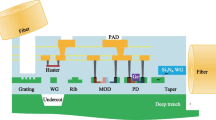Abstract
Hierarchy plays a significant role in the design of digital and analog circuits. At each level of the hierarchy it becomes essential to evaluate if a sub-block design is feasible and if so which design style is the best candidate for the particular problem. This paper proposes a general methodology for evaluating the feasibility and the performance of sub-blocks at all levels of the hierarchy. A vertical binary search technique is used to generate the feasibility macromodel and a layered volume-slicing methodology with radial basis functions is used to generate the performance macromodel. Macromodels have been developed and verified for both analog and digital blocks. Analog macromodels have been developed at three different levels of hierarchy (current mirror, opamp, and A/D converter). The impact of different fabrication processes on the performance of analog circuits have also been explored. Though the modeling technique has been fine tuned to handle analog circuits the approach is general and is applicable to both analog and digital circuits. This feature makes it particularly suitable for mixed-signal designs.
Similar content being viewed by others
References
R. Harjani, R. A. Rutenbar, and L. R. Carley, “OASYS a framework for analog circuit synthesis”,IEEE Transactions on Computer-aided Design of Integrated Circuits and Systems, December 1989.
E. S. Ochotta, R. A. Rutenbar, and L. R. Carley, “AS-TRX/OBLX: Tools for rapid synthesis of high-performance analog circuits”, inACM/IEEE Design Automation Conference, 1994.
S. W. Director and G. D. Hachtel, “The simplicial approach to design centering”,IEEE Transactions on Circuits and Systems, July 1977.
R. K. Brayton, G. D. Hachtel, and A. S. Vincentelli, “A survey of optimization techniques for integrated-circuit design”,Proceedings of IEEE, October 1981.
K. K. Low,A Methodology for Statistical Integrated Circuit Design. PhD thesis, Carnegie Mellon University, Pittsburgh, Pennsylvania, 1989.
M. C., Bernardo, R., Buck, L., Liu, W. A., Nazaret, J., Sacks, and W. J., Welch, “Integrated circuit design optimization using a sequential strategy”,IEEE Transactions on Computer-Aided Design, vol. 11, pp. 361–372, March 1992.
J. Shao and R. Harjani, “Feasibility region modeling of analog circuits for hierarchical circuit design”, inIEEE Midwest Symposium on Circuits and Systems, 1994.
Y., Aoki, H., Masuda, S., Shimada, and S., Sato, “A new design centering methodology for vlsi device development”,IEEE Transactions of Computer-Aided Design of Integrated Circuits, vol. CAD-6, pp. 452–461, May 1987.
A. R., Alvarez, B., Abdi, D., Young, H., Meed, J., Teplik, and E., Herald, “Application of statistical design and response surface methods to computer-aided VLSI device design”,IEEE Transactions of Computer-Aided Design of Integrated Circuits, vol. CAD-7, pp. 272–288, February 1988.
T., Yu, S., Kang, I., Hajj, and T., Trick, “Statistical performance modeling and parametric yeild estimation of MOS VLSI”,IEEE Transactions of Computer-Aided Design of Integrated Circuits, vol. CAD-6, pp. 1013–1022, November 1987.
P., Cox, P., Yang, S., Mahant-Shetti, and P., Chatterjee, “Statistical modeling for efficient parametric yield estimation of MOS VLSI circuits”,IEEE Transactions on Electron Devices, vol. ED-32, pp. 471–478, Feb 1985.
C. Shyamsundar, “Mulreg — user's manual”, technical report, Carnegie-Mellon University, 1986.
G. Box, W. Hunter, and J. Hunter,Statistics for Experimenters: an Introduction to Design Data Analysis and Model Building. John Wiley, 1978.
L. M., Vidigal and S. W., Director, “A design centering algorithm for nonconvex regions of acceptability”,IEEE Transactions on Computer-Aided Design of Integrated Circuits and Systems, vol. CAD-1, pp. 13–24, January 1982.
M. Powell, “Radial basis functions for multivariable integration: A review”, inIMA Conference on Algorithm and Approximations and Data, RMCS, 1985.
V. Cherkassky, D. Gehring, and F. Mulier, “Pragmatic comparison between statistical and neural network methods for function estimation”, inProc. World Congress on Neural Networks WCNN-95, July 1995.
J. Shao and R. Harjani, “Macromodelling of analog circuits for hierarchical circuit design”, inIEEE International Conference on Computer Aided Design, 1994.
R. Gregorian and G. Temes,Analog MOS Integrated Circuits for Signal Processing. Wiley and Sons, 1986.
J. C. Candy and G. C. Temes, eds.,Oversampling Methods for A/D and D/A Conversion, pp. 1–25. IEEE Press, 1992.
R. Harjani,The Circuits and Filters Handbook, ch. Analog-to-Digital Converters. CRC Press, 1995.
Author information
Authors and Affiliations
Additional information
This research was supported in part by a grant from NSF (MIP-9110719)
Rights and permissions
About this article
Cite this article
Harjani, R., Shao, J. Feasibility and performance region modeling of analog and digital circuits. Analog Integr Circ Sig Process 10, 23–43 (1996). https://doi.org/10.1007/BF00713977
Issue Date:
DOI: https://doi.org/10.1007/BF00713977




